During the 1990s multiple specific and distinctive plant abnormalities were repeatedly documented in several hundred different crop formations which had occurred in various European countries as well as in the States and Canada. Extensive laboratory examination of thousands of these crop circle plants and their controls by American biophysicist W. C. Levengood established the presence of consistent changes in the circle plants which were not present in the control plants (plants taken at varying distances outside the crop formations, but in the same fields) -- changes which control studies revealed were not caused by simple mechanical flattening of the plants (with planks, boards, cement rollers or human feet).
Because some crop formations are known to be mechanically flattened by people (see a vain attempt by some M.I.T. undergraduates in Ohio, in 2002: http://www.bltresearch.com/published/mit.php) circle enthusiasts have long desired simple indicators of the "real McCoy" -- in particular, parameters they could easily recognize while out in the fields. And while we appreciate this desire, the BLT Team's plant and soil research indicates that any reliable determination requires the documentation of multiple plant and/or soil abnormalities -- some of which documentation does require microscopic or other laboratory analysis -- to ascertain with certainty the origin of any specific event.
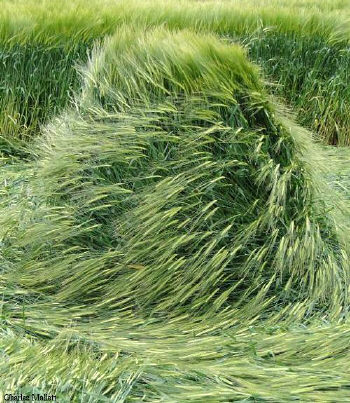 |
Fluid "lay" of barley plants inside the June 12th "Phoenix"
formation. Photo: Charles Mallett |
However, there are four scientifically-documented visible plant changes which are hallmarks of genuine crop circles -- and all of these, if present, are (a) thought to be caused by the exposure of the plants to the heating component (most likely microwave radiation) of a plasma energy discharge which our work indicates is involved in the creation of many crop circles, and (b) except for the inhibited seed/seed-head development, the other three will be present immediately after a formation occurs:
1. | elongation or stretching of the apical nodes (the first node beneath the seed-head), as compared to the control nodes. |
2. | expulsion cavities (holes blown out at the nodes, usually found in the 2nd and/or 3rd nodes beneath the seed-head), as compared to control plants at various distances away from the formation, (but not along the tramlines). |
3. | distinct bending of the plant stems at the nodes, which can occur at any or all of the nodes -- this parameter is useful only if one knows both the growth-stage of the crop when the circle occurred and how much time has elapsed since then, because young and vigorously-growing plants will produce nodal bending within days of being flattened (so long as they are not crushed), as they begin to reorient themselves to the sun and to gravity (phototropism and gravitropism. Mature crop which has begun to dry down does not have the energy required for these natural recovery processes and, so, marked node bending in circles which occur in this later growth-stage is much easier to recognize as significant. |
4. | inhibited seed-head development, which is usually only apparent in crop formations which have occurred fairly early in the season but are being examined at least 3-4 weeks later. In early genuine formations the seed-heads in the flattened crop will usually be visibly smaller and less well-developed 3-4 weeks later, and in many cases the glumes have been found to contain no seeds at all. |
There is a fifth visible plant alteration -- bending at the base of the plant -- which can be also be highly significant but, as in the case of nodal bending, it's significance is dependent upon both the type of plant involved and the age of the crop at the time the formation has appeared. Young cereal plants are quite flexible and when flattened mechanically will often bend at the base rather than break; however, marked bending at the base in certain plants (such as canola, which has a thick stalk which breaks easily) or in older crop, particularly if it has reached the drying stage, is quite likely to be highly significant (since mechanical flattening at this stage will crush, not bend, the plant base).
In addition to the visible changes discussed above the BLT Team has always (if attempting to determine "authenticity" of a specific crop circle) taken into consideration additional parameters which require lab analysis to estabish. These are (a) marked germination abnormalities in the crop circle seeds; (b) the presence of node-length changes which correlate with the well-known law of physics (the Beer-Lambert principle) which predicts the effect of exposure to EM energies on matter; (c) the presence and distribution patterns of microscopic, magnetized iron spherules in the soils; and (d) after the completion of the x-ray diffraction study in 2002, the increased ordering of the crystalline structure of specific clay minerals in crop circle soils.
We do not have the funding needed to repeatedly replicate the in-depth field and lab work carried out (and published in refereed journals) during the1990s. But since it has been many years since BLT examined UK crop circles we were curious to know if some of the recent British formations continued to exhibit these same visible plant changes documented so thoroughly during the 1990s and which we associate with authenticity.
Because in-depth sampling and subsequent intensive laboratory work was not carried out in 2009 we cannot be 100% certain that the visible plant changes we found are absolute proof these formations were genuine. But an educated estimate can be offered in several instances.
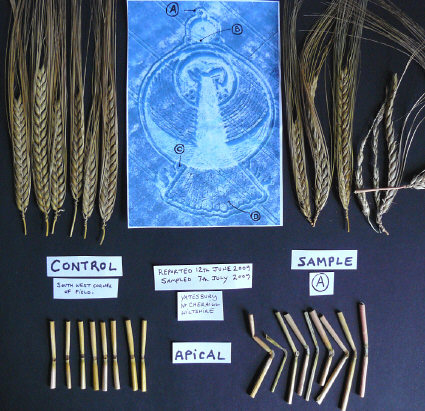 |
Sample seedheads from inside the "Phoenix" show clearly retarded development
(as compared to their controls) 25 days after formation appeared,
as well as marked apical node elongation. |
Randomly-Downed Crop
In the 1990s BLT also regularly sampled plants in areas of randomly-downed crop often found near "geometric" formations and discovered that the plants in these areas frequently contained the same plant changes found in the "geometric" formations themselves -- suggesting that these plants were also exposed to the plasma discharge the evidence indicates was present during the creation of the "geometric" designs. Further, in multiple previous instances where randomly-downed areas have been sampled and tested, the plant abnormalities present have been even more pronounced than those documented in the circles themselves.
In some cases randomly-downed crop is caused by weather damage and, occasionally, by over-fertilization (called "lodging" by farmers) -- but when one is looking at lodging the only visible plant abnormality one could expect to see would be node bending -- and this only if the crop was still vigorously growing when affected and, also, only when enough time has elapsed for the plants' natural recovery processes (phototropism/gravitropism) to cause the node-bending as the plants reorient themselves to the sun and gravity.
In 2009 our British fieldworker examined a number of these randomly-downed or partially-downed areas in the fields -- in particular when they were present close to "pictorial" or "geometric" circles. In the case of the "Phoenix" he found a series of partially-downed "splashes" just above the "head" area of the "Phoenix," and his samples of this area revealed both apical node elongation and expulsion cavities in the 2nd nodes.
Again, it must be noted that apical node elongation and expulsion cavities were not found in the controls taken from standing crop near the SW corner of the field.
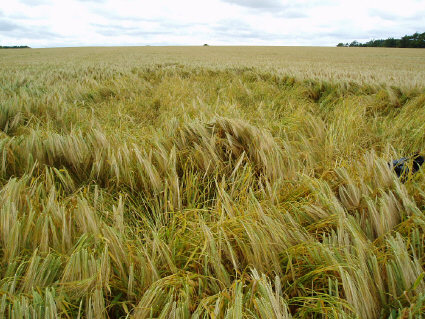 |
A randomly-downed area of barley found near one end of the "Phoenix." Partially-
flattened and/or non-geometric flattening like this does, in some cases,
show the same plant effects as are found in the formations. |
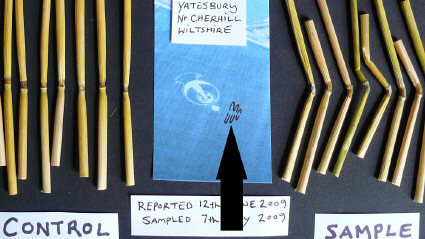 |
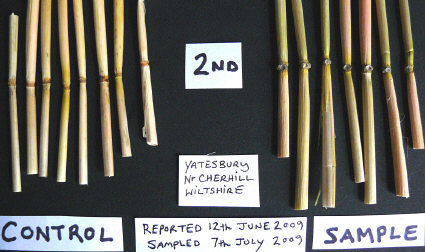 |
Elongted apical nodes (top) & expulsion cavities (bottom) in the 2nd nodes
in randomly-downed "splashes" near "Phoenix." |
A Los Angeles TV crew--the same group which discovered the "Mayan Mask" opposite Silbury Hill (see Part 2) -- reports that the "Dragonfly" formation discovered on June 3rd in this same field was "full of blown nodes," which they carefully filmed. And, although our fieldworker did not examine the "Dragonfly," a photo posted on the Crop Circle Connector ( http://www.cropcircleconnector.com/) shows a massively elongated apical node (with equally extreme node bending) in a plant which apparently came from the "Dragonfly" shortly after it's discovery. If that plant was typical of the rest of the downed crop inside the "Dragonfly" (and with the film documentation of expulsion cavities throughout) there could be no doubt of that formation's authenticity.
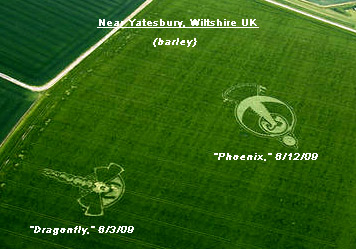 |
Two highly-interesting June '09 formations in same field
near Yatesbury. Photo: Frank Laumen |
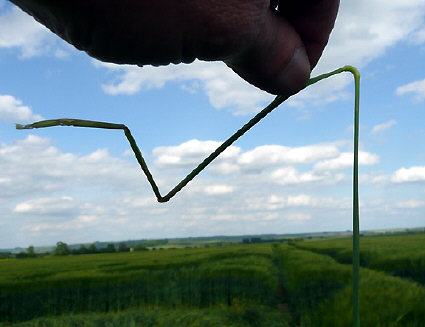 |
Massive apical node elongation and marked nodal bending in plant from June 3rd
"Dragonfly." Film crew reports the formation was also "full of blown nodes,"
plant changes which are not caused by mechanical flattening.
Photo: Mark Vidler |
Is a Consciousness of Some Kind Involved?
In June 2009 two of our European colleagues spent a few days in Wiltshire, examining several of the formations which had already appeared. These colleagues have considerable experience in the UK fields and were not only surprised by the new "pictorial" design style so much in evidence in 2009, they were not at all sure how to evaluate the "lay" quality observed in some of these formations, particularly in the "Dragonfly."
On the night of June 11th, while walking along the farm track next to the "Dragonfly," they found themselves wishing for a new formation to arrive that night in the same field, near the "Dragonfly" -- and what they discussed was a fairly simple "geometrical" design, perhaps a plain circle but with some sort of "special feature" which they might be able to recognize as a "response" to their wish. Specifically, they talked about a piece of this simple circle being "moved outwards," and there being a standing section like a "slice of cake."
The next morning (June 12th) the "Phoenix" was discovered in the Yatesbury field in a spot directly opposite the place where our colleagues had been standing in the farm-track next to the field when they "wished" for a simple design to appear. But it, of course, could hardly be considered a "simple" design...and it was clearly as "pictorial" as the "Dragonfly."
But on the following day another new formation was found just below Milk Hill, near Stanton St. Bernard. This formation was both smaller and of a much simpler design and it was also mostly symmetrical. Both men were shocked when they discovered the protruding outer ring around one of the six circles and the small triangularly-shaped section of standing crop in this same circle, immediately recalling their request two days previously for a special feature: "one section of the circle should be moved outwards," and there should also be a standing feature "like a slice of cake."
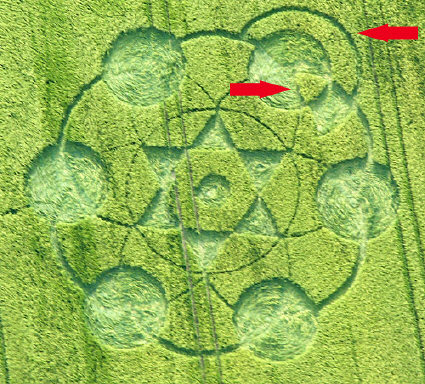 |
June 13th formation below Milk Hill, with geometric "aberrations" (arrows, upper R)
which seem to precisely reflect those specifically requested.
Photo: John Montgomery |
As many have wondered over the years when specific design elements have appeared after being imagined or actually requested, or crop circles have occurred in precise locations privately thought to be "a perfect place for a cropcircle," our two colleagues here -- both basically of a skeptical bent -- could not help pondering whether it could possibly be that someone, or something, was listening? And not only listening, but answering?
In this case the "Phoenix" formation appeared the very next day and in almost the exact spot these men had wished that a new formation would appear -- but its overall design was totally unlike what had been desired. And then, the following day but in another location entirely, another new and much simpler design did appear -- and this time did include a "special feature" -- one which certainly looks like the precise design anomaly which they had discussed out loud two days earlier.
With no prior knowledge of this set of circumstances related to the June 13th Milk Hill formation, our 2009 UK fieldworker just happened upon it on his second trip to Wiltshire early in July, and he sampled it 26 days after it had formed. Here's what he found:
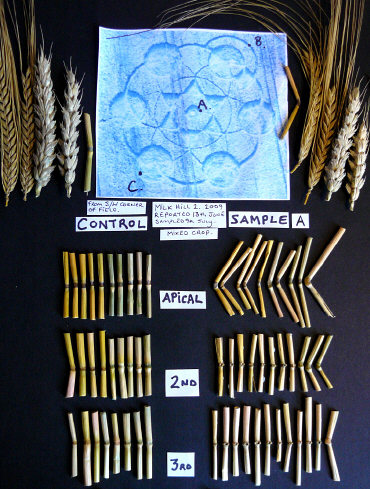 |
June 13th Milk Hill formation with precise design anomalies requested
two days earlier. Formation occurred in section of field
which contained both wheat and barley. |
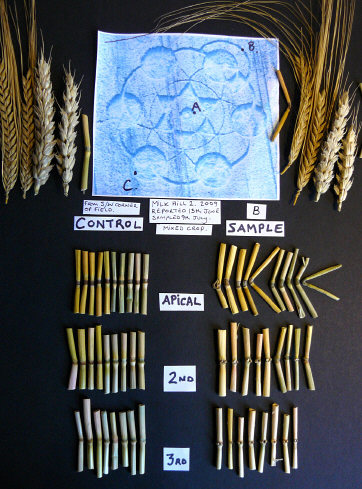 |
Sample B (from "anomalous" extended ring area) also showed marked
plant abnormalities in all 3 nodes. |
Even with only three sets of samples and controls we can be very close to certain -- with clearly visible apical node elongation in nearly all the samples and expulsion cavities not only in nearly every 2nd but also 3rd node--that this formation was not flattened with planks or boards. It may be that the question here should be more along the lines of "could it possibly be that someone or something really WAS listening?"
A Small, Two-Phase Formation
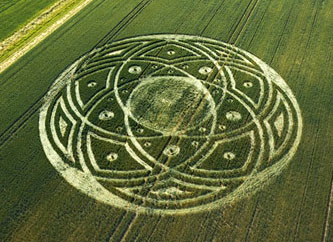 |
2-phase formation at Honey Street. Center circle appeared on
June 27th; elaborate addition on July 6th.
Photo: Steve Alexander |
Another of the relatively small (as compared to some other formations which appeared in 2009) crop circles -- but one which occurred in two phases -- is more difficult to evaluate. Our fieldworker did sample both phases on July 10th, with both samples from the first phase (center circle) showing only moderate apical node lengthening but definite expulsion cavities in most of the 2nd and 3rd nodes.
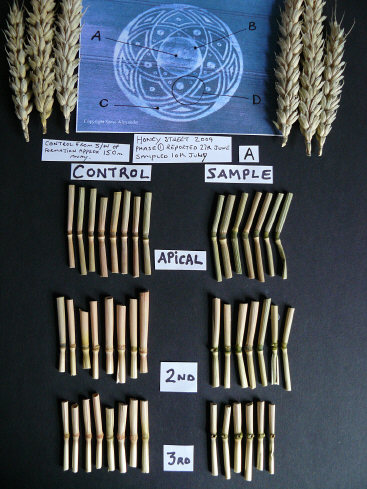 |
Sample A from phase #1 of Honey Street formation shows no obvious
change in seed-head development and only moderate apical
node lengthening, but expulsion cavities in
2nd and 3rd nodes. |
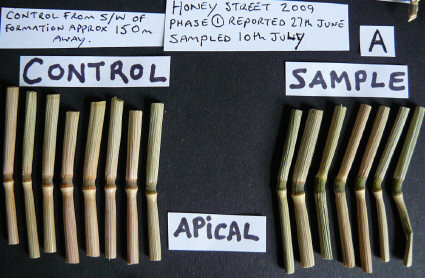 |
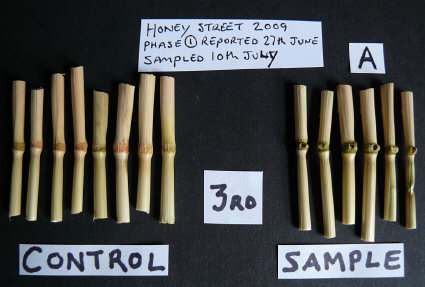 |
Moderate apical node elongation & expulsion cavities in 3rd node
beneath seed-head in plants from center circle. |
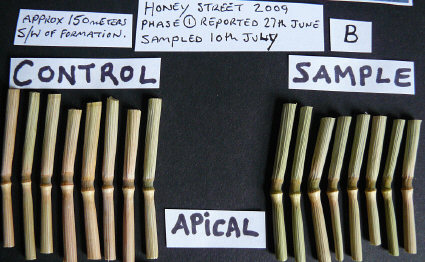 |
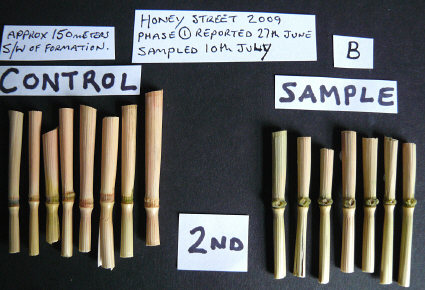 |
Sample B from center circle shows slightly greater apical node-length
elongation and expulsion cavities in 2nd nodes. |
Changes in plant samples from phase #2 of the Honey Street formation (Samples C & D) show what may be slight apical node elongation -- and a few expulsion cavities are present in some of the 2nd and 3rd nodes -- but the changes here are markedly less clear than in phase #1.
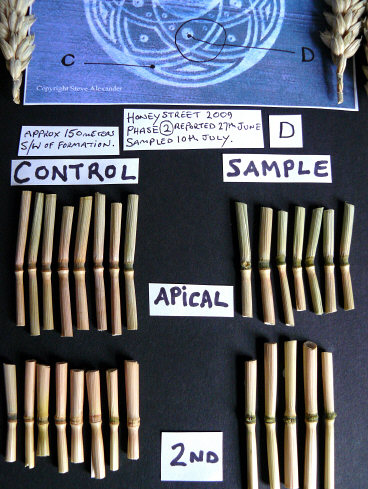 |
Slight apical node change in Sample D, from phase #2.
One expulsion cavity is present in apical nodes. |
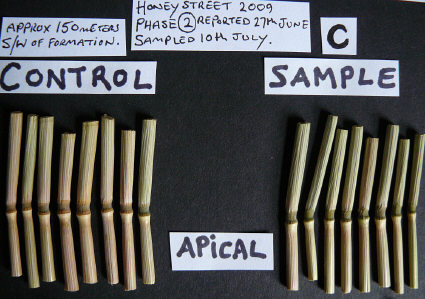 |
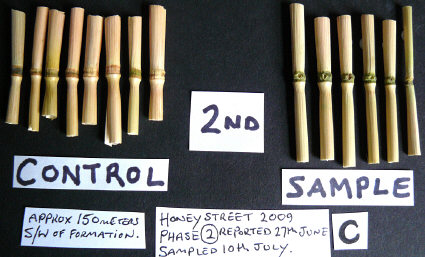 |
Again, apical node lengthening is not certain in Sample C from
phase #2; expulsion cavities are present in 2nd nodes. |
The sample size is not large enough in phase #2 to reach any reliable conclusion. It is possible here that the time difference between when the two phases appeared in the field and sampling was carried out (phase #1=14 days, phase #2=5 days) is of significance. As the plants dry down the apical node-length increase, when present, becomes more apparent (this also applies, of course, to the controls). So, when there is significant node-elongation it is often easier to see (and to measure) once the plants have dried down fully.
We thought it would also be helpful to note Charles Mallett's usually very reliable field observations regarding this formation: he states he observed a "significant number" of biological anomalies ("blown" nodes and/or elongated nodes) in Phase #2 ( http://www.silentcircle.co.uk/rpt092.html).
Two final points needs to be made. Based on the data derived from the crop circle research carried out by BLT in the 1990s it is clear that there is some degree of variation in the discharge intensity level of each interacting component of the energy system involved in creating genuine crop circles. In some circles it has been clear that the heat discharge, although very brief in all cases, was quite intense--whereas in other formations the degree of heat seems to have been relatively mild. It is also clear that the magnetic field strength and electrical component vary from case to case, and can even vary from one location to another in a single formation (a situation which then requires an enormous sampling effort in very large, complex events such as those occurring in recent years).
There is also substantial evidence of what we have termed a "spillover" effect in some of the larger formations during the '90s, with standing crop outside the formations showing exposure effects up to several hundred feet outside the downed-crop perimeters. And in fields in which very large formations occur, or multiple circles form in one summer, there is a distinct possibility that the entire field will have been affected.
The circle phenomenon is very complex...and so all of the facts established so far (and likely others which have not yet been discovered) must be taken into account when attempting to evaluate "authenticity" of any given event. ****** - PART 2 -
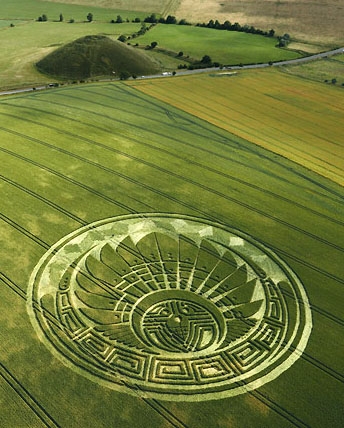 |
July 5, 2009 - Silbury Hill "Mayan Mask" with unique undulating effect
around top of "mask" created by light reflection off the
unusual lay. Photo: Steve Alexander |
All seed-head & node photos are the property of the BLT Research Team Inc and may be used by others with written permission from Nancy Talbott. Please contact individual photographers of various crop formations if permission is desired to use their photos. |
One of the 2009 formations which attracted a lot of attention was this one, which appeared in the field across the A4 from Silbury Hill. A Los Angeles film crew happened to be conducting a "night watch" on top of Silbury Hill the night this formation occurred and, although they were awake and watching all night, they neither saw nor heard anything unusual during the approximately 5 hrs. of darkness before one of their group discovered the circle at first-light, around 4:30am.
A camera-man from the film crew was the first person into this formation and he arrived about 20 minutes after first discovering it, before the sun had yet risen. His footage (which I have seen) clearly shows node bending was presentimmediately, and in multiple plant stem nodes inside the circle.
We were curious about this formation and pleased to learn that our BLT fieldworker did visit it, although not until 25 days after it had appeared and, unfortuntely, only briefly. Because there were other formations he wanted to examine on this trip, he did not spend as much time in this formation as we now all wish he had.
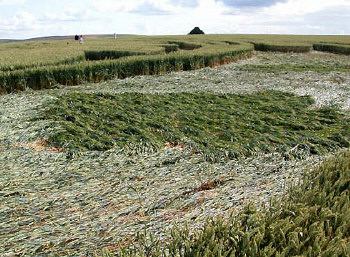 |
One section of unusual lay pattern around top of "mask" which
creates undulating light reflection in aerial shots.
Photo: Mike Callahan |
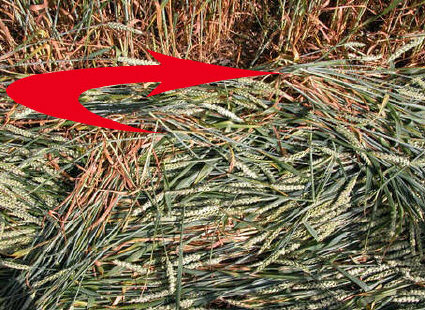 |
Plant stem nodes in flattened sections are bent downward rather than up
(as they would be 25 days after the formation occurred if
bending was due to photo -- and/or gravitropism).
Photo: Mike Callahan |
The few samples we have from the "Mayan Mask" were obtained 25 days after it appeared and, in comparison to the controls, do not exhibit any obvious signs of developmental inhibition of the seed-heads.
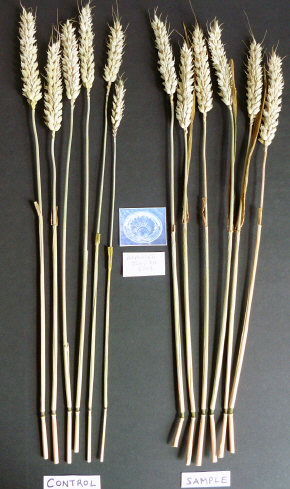 |
Seed-head development appears unaffected 25 days after
the July 5th "Mayan Mask" occurred, but moderate
apical node elongation can be seen. |
But in addition to the downward-bending nodes in Mike Callahan's photo (above), we can see that the apical nodes (1st nodes beneath the seed-heads) do show moderate elongation in our few samples, as well as expulsion cavities in several of the 2nd nodes.
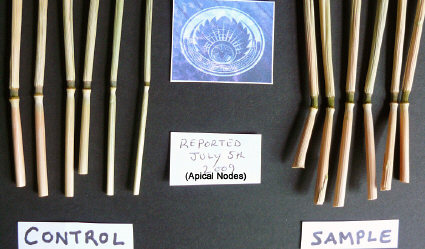 |
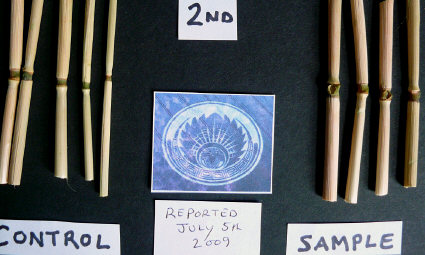 |
Sampling 25 days after "mask" appeared shows some apical node
elongation & expulsion cavities in 2nd nodes. |
We can offer only a tentative conclusion regarding this formation's origins based on (a) the fact that node bending was filmed within a half-hour of the circle's discovery, (b) the node bending is downward (instead of upward as would be the case if caused by photo- and/or gravitropism), (c) there is moderate apical node elongation in the few samples we have, and (d) there are some expulsion cavities in the 2nd nodes -- all of which indicate exposure of the plants to energies known to be associated with a plasma discharge.
Had the sample size been considerably larger and the apical (top) node elongation and presence of expulsion cavities in the 2nd nodes been aconsistent finding in a much larger sample, we would have been able to be much more certain.
Strange Camera Effects
We do have an interesting anecdote regarding this formation. Sometime between July 27th-July 30th a small group of tourists, including Dean and Margaret DeHarpporte from Minnesota, were visiting the "Mayan Mask." Margaret had taken a few photos (all normal) with their digital camera when they first arrived, but a British TV production crew was interviewing one of the group and she turned the camera off and handed it to her husband, who put it in his pocket and then lay down to wait for the interview to be over.
Dean thinks the interview went on for a good half-hour, perhaps longer. When it was finally over he got up and turned his camera back on to take a few more photos before the light faded -- but immediately saw a very strange image appear on his LED screen. He realized that, when he pointed the camera at one or another section of the field, he could see what was actually in front the lens-but only faintly, and behind the odd LED display.
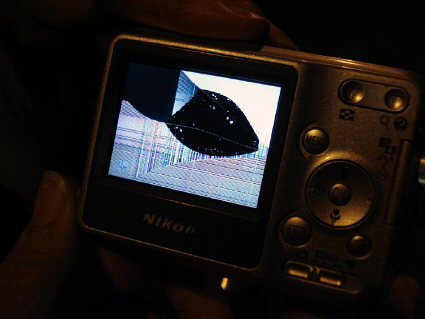 |
Strange LED image which appeared on the DeHarpport's camera while inside the
"Mayan Mask." The image stayed on the LED screen in spite of new
batteries being installed. Photo: Lindy Tucker |
When the chip was taken out of this camera and placed in another so the photos previously taken could be viewed, this image on the LED screen was not on the camera's chip -- so it is not an actual photograph, but some sort of artifact on/in the LED screen itself. It is possible that Dean may have damaged the camera by lying on it, thus causing this odd LED display, but photos taken subsequently with the camera appear normal, with no trace of this LED screen image on the new photos -- although the camera's shutter mechanism now "rapidly closes and opens after a photo is taken until the camera is given a whack to make it quiet down." And the peculiar LED screen image re-appears after new photos are taken.
Interestingly, the British TV crew which was in the "Mayan Mask" at the same time as the DeHarpports, upon seeing the strange image on Dean's LED screen, remarked that one of their professional TV cameras had "failed completely" while they were filming in this formation a few days earlier.
Another totally separate and quite peculiar incident occurred during the DeHarrporte's 2009 UK visit. Upon their arrival to their Marlborough hotel, the key to their room suddenly softened "like jelly" and twisted as Dean inserted it into the lock, making it impossible for them to open the door. They were unable to get into their room and another key had to be made. Dean reports that the key was not hot when it softened spontaneously and said that this was the first time he had personally experienced anything as unusual as this.
Small Components of Formations Often Show
Greater Plant Changes
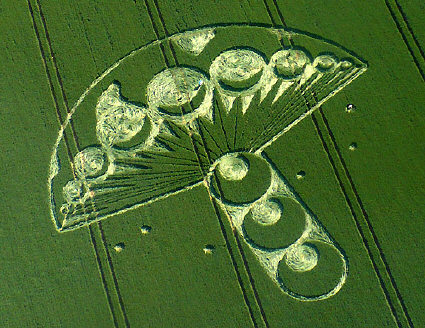 |
June 24, 2009 -- Rough Hll "mushroom," in wheat.
Photo: Russell Stannard |
An additional formation examined by our fieldworker appeared on June 24th at Rough Hill. Over the years the BLT work has often revealed greater damage to the plants in smaller circles, or smaller components of larger formations, than that which is found in the larger circles or in the larger flattened sections of some formations. Since the deleterious effects to the plants are thought to be caused by microwave radiation exposure (the energy that causes reduction in seed-head growth, elongation of the apical nodes and the expulsion cavities), it makes sense that the radiation in smaller, more confined areas might be more intense, thus causing greater visible plant damage.
The plant changes found in Sample B (taken from the small "grapeshot" on the left, nearest the tramline in photo above) revealed a clear reduction in seed-head development -- which was not seen in Samples A and C, taken from larger downed-crop areas. All three sample sets did contain expulsion cavities in all of the 2nd nodes beneath the seed-heads, as well as in some of the 3rd nodes.
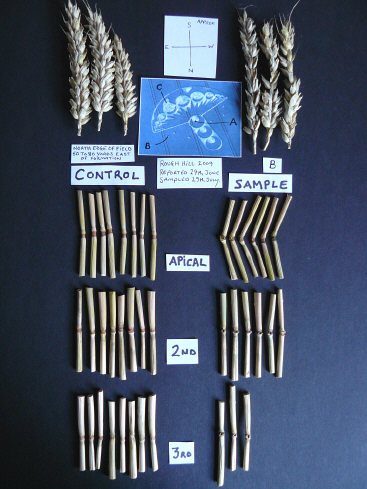 |
Sample B (from small "grapeshot"), taken 1 month after formation appeared,
shows inhibited seed-head development -- not found in samples A & C,
taken from larger areas of flattened crop. |
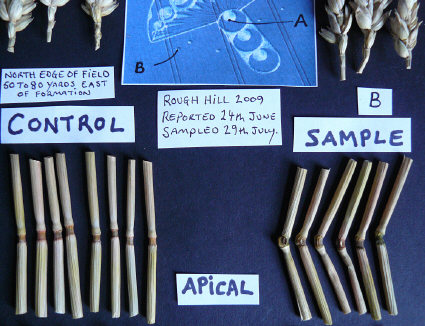 |
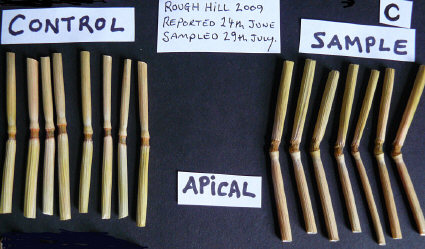 |
Apical node elongation, if present here, is subtle & would therefore
require more extensive sampling with laboratory measurements
& statistical analysis to ascertain. |
Effects to Plants Along Tram-Lines Which
Run Through Formations
Expulsion cavities, one of the primary visible plant changes associated with authentic crop circles (and which have been found only very rarely in the many thousands of control plants examined by BLT over the years), can also occur in plants bordering the tram-lines -- particularly, but not exclusively, in tram-lines which run through the crop circle itself. If microwave radiation (one of the energies involved in the plasma discharge and the one which we believe is instantly turning the moisture inside the plant stems -- most particularly at the nodes -- into steam) is what is causing the exposed plant nodes to "explode," then finding similar effects caused by the microwaves in plants along these tram-lines makes very solid sense.
Plasmas (electrified air masses which carry electric charge when traveling through a magnetic field) emit microwaves when they spiral -- and certain shapes called "waveguides" -- attract plasma "like bees to honey" (see John Burke's article " The physics of Crop Formations," sections entitled "Natural Causes" and "Deterministic Chaos" on the Published Papers section of the BLT web-site: http://www.bltresearch.com/published/physics.html). The long straight tractor lines (which function like 3-sided rectangles) are one well-known waveguide shape which, in the crop circle situation, can channel the microwaves for a considerable distance away from the actual formation, thus exposing the plants along these tram-lines to some of the radiation involved in the plasma discharge which creates the actual formation.
Our fieldworker paid special attention to the tram-lines running through formations and some which did not, and also looked at the tram-lines in the corners of fields, where the tractors often turn around. We do not yet have enough data to complete a report about plant changes sometimes found in these areas, but hope to gather enough data in the next few years to do so.
In the Rough Hill formation (and several others we examined in 2009) we did find some expulsion cavities (and a few elongated apical nodes also) in plants running along tramlines that went through the actual formations themselves, but at a considerable distance away from the crop circles.
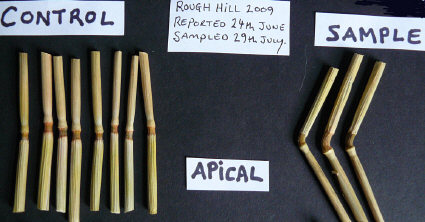 |
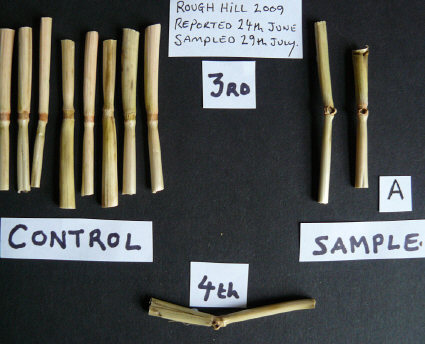 |
Elongated apical nodes and expulsion cavities in 3rd & 4th nodes
in plants along tram-line running through Rough Hill circle. |
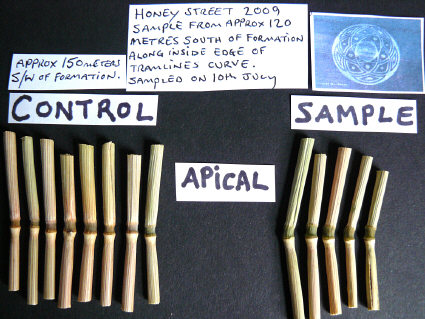 |
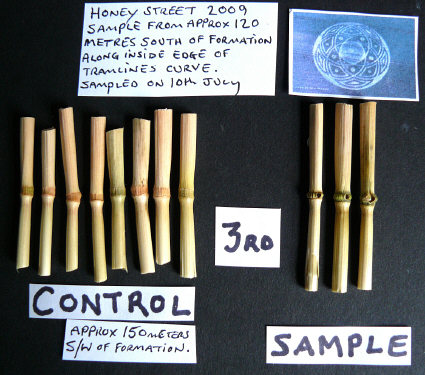 |
Possible apical node elongation and expulsion cavities in 3rd nodes of
plants in tram-line 120m south of Honey St. formation. |
We suspect that the changes sometimes found in plants along the edges of tram-lines -- particularly those tram-lines which run through crop circles -- is evidence that these long straight lines in the fields are functioning as wave-gudes. Whether it is the intensity level of the microwaves in any particular event, or the length of time involved in their discharge, or perhaps the angle of impact or the overall size and/or complexity of the plasma energy system itself which dictates in which instances tram-lines would function in this manner remains to be discovered.
The fact that these plant changes are also occasionally found in tram-lines not directly related to existing formations or in corner areas of some fields where no formation exists needs more research to understand.
Are Plants in Entire Fields Affected When Large
and/or Multiple Circles are Present?
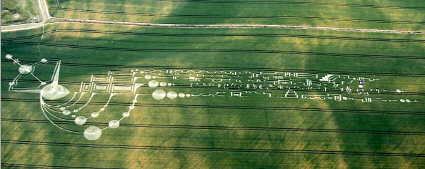 |
400m-long formation beneath Milk Hill which appeared in 3 stages on
June 21, June 23 & June 30, 2009. Photo: Olivier Morel |
 |
Samples taken in each stage (A1, B1, C1 & A2 = Stage #1;
B2, C2=Stage #2; A3, B3, C3=Stage #3).
Photo: Lucy Pringle |
This amazing formation is very difficult to evaluate -- not only because of its enormous size, but primarily because the apical nodes in the control plants (all taken from the SE corner of this field) look nearly as elongated as are the apical nodes in the samples. Additionally, seed-head development in all of the samples appears normal and there were no expulsion cavities found in any of the 2nd nodes, and only a very few in the 3rd nodes. These conditions are the same in all the samples taken from each of the three "phases" of this formation.
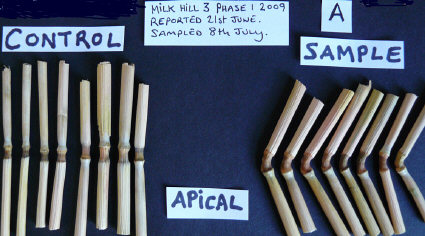 |
Close examination of the apical nodes from Sample A in phase #1
reveals considerable node elongation -- but so do many of
the "control" plants from the SE corner of the field. |
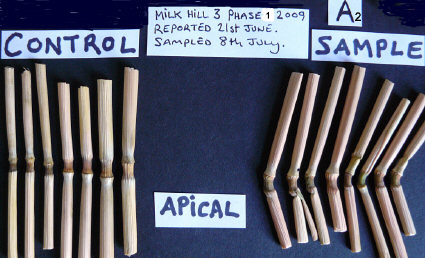 |
This is also the case with Sample A-2 (also from phase #1,
although our fieldworker mistakenly marked it
originally as coming from phase #2). |
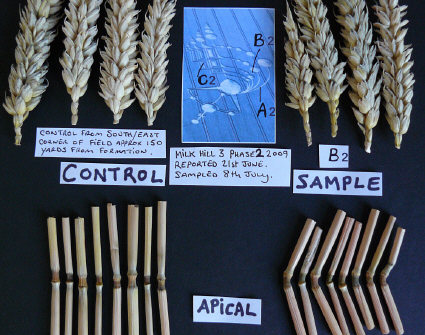 |
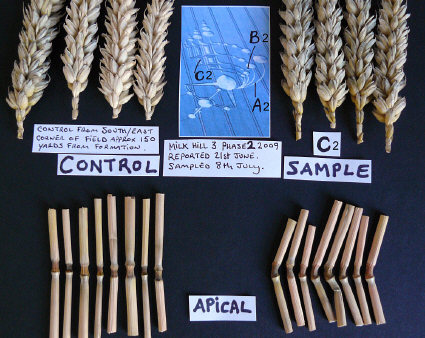 |
Two sets of samples from phase #2 (June 23rd) which again reveal
normal seed-head development and apical node elongation
in the samples, but also in many of the "controls." |
The problem here, of course, is how to interpret these results. Apical node elongation ("stretching" or "lengthening" of the first node beneath the seed-head) is the best-documented and most reliable visible plant change indicating authenticity established by the BLT work during the 1990s. The presence of expulsion cavities found in the lower stem nodes is also a strong indicator, but we know that these do not always occur in genuine formations (circles in which in-depth sampling and subsequent lab analysis in the past documented enough other factors to indicate authenticity) -- and based on our earlier work we know that this is particularly true of British formations.
So, in this case, where pronounced apical node elongation does appear to be present (but in both the samples and the controls) -- but with no expulsion cavities in the 2nd nodes and only a few in the 3rd nodes -- and with what also appears to be normal seed-head development in all of our samples, we're again confronted with the need for much more extensive sampling and statistical analysis, as well as germination trials and other laboratory analysis.
However there are two other factors which may be applicable here. We know, from previous work, that in some formations there is what we have termed a "spillover" effect -- a situation where the nodes of standing plants outside formations have been found to be altered up to a distance of 350 ft. away from certain formations which occurred in the 1990s. In these cases the actual "control" plants did not begin until our samplers were 350 ft. away from the flattened crop circles.
Therefore, in this case, we probably must consider the number of formations which were already present in the adjacent field, in addition to the small 2-phase circle which occurred in the S-SE area of this very same field and on two of the exact same nights as did phase #1 and #2 of the huge 3-stage formation.
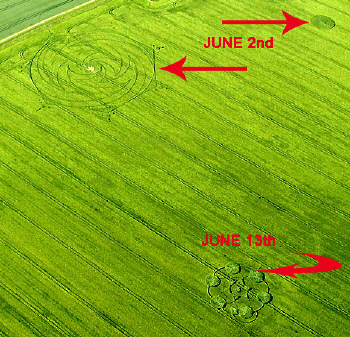 |
Three circles already present in field adjacent to one in which the
3-phase formation later appeared.
Photo: John Montgomery |
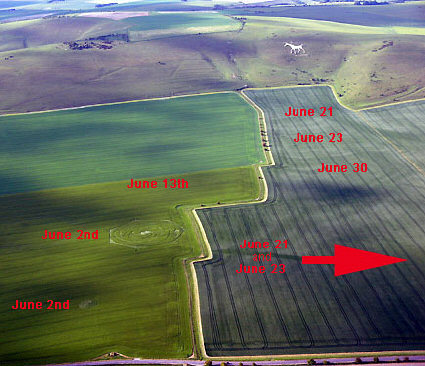 |
June 2 & June 13th formations next to field in which 3-phase event
& small June 21-23 circle also subsequently occurred.
Photo: John Montgomery |
We must also note that this small (and atypically-flattened) circular area in the southern section of the field below the white horse was also found to have an "addition" on the same date that phase #2 of the larger formation was discovered. With this amount of activity in a relatively small area it is possible that many, if not all, of the plants in the 3-phase Milk Hill field could have been repeatedly exposed.
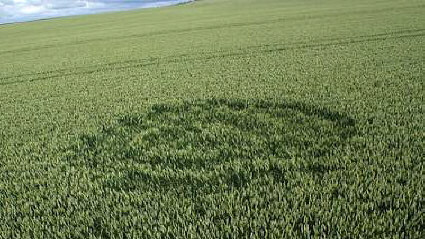 |
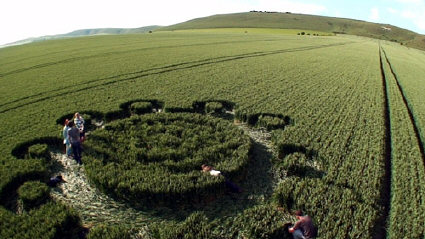 |
Phase #1 (top) of small crop circle found on June 21st and with "addition" (bottom)
found June 23rd; this circle was in southern section of same field in which
3-phase formation also appeared. Photo: Stuart Dike. |
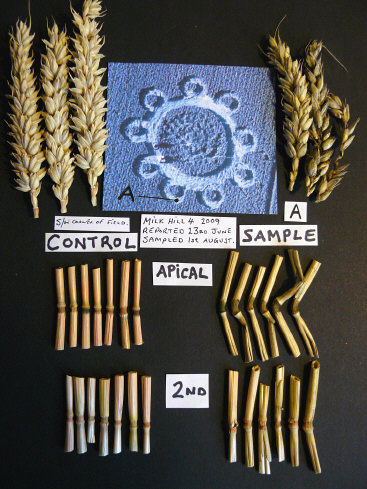 |
Sample A from the 2nd phase of the small unusual circle at Milk Hill
(Milk Hill #4) reveals impaired seed-head development, extreme
apical node elongation & expulsion cavities in 2nd nodes. |
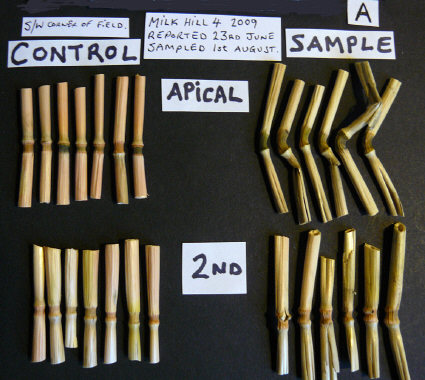 |
Extreme apical node elongation is clearly present in the sample plants
when compared to controls taken from SW section of the
Milk Hill field. |
Finally, and I think most importantly, we must consider the (in retrospect) unfortunate fact that our fieldworker took all of his "control" plants for this huge Milk Hill 3-phase formation from the SE corner of that field. It turns out that there were several small, odd, flattened areas in this section of the field, as well as the smaller 2-phase circle ("Milk Hill #4," arrow) whose first phase was found on the same date as phase #1 of the larger event and whose second phase appeared on the same date as phase #2 of the larger formation up closer to the white horse.
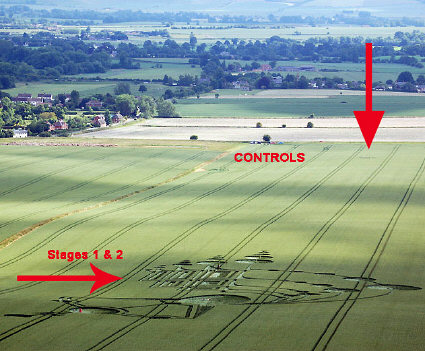 |
Proximity of 3-phase formation, the smaller Milk Hill #4 circle (arrow) & the
SE corner of field where controls for 3-phase event were taken.
Photo: Stuart Dike. |
Since we know from the intensive sampling and lab analysis carried out by BLT in the 1990s that a "spillover" effect into standing crop beyond the flattened perimeters of crop circles can -- and does -- occur in some events, and because all of the "controls" for this 2009 3-phase formation at Milk Hill were taken from an area that might well have been affected by other plasma discharges in several other events nearby, and also because we have never seen "control" plants previously in which the apical nodes looked as affected as those in these "controls," we have reason to ask seriously if we actually have any real "controls" for the 400m-long, 3-phase formation.
It is my personal opinion, based on 10 years of scientific evaluation of crop circle plants and my continuing expeditions into crop circle fields in multiple countries and my examination of plants in those situations, that significant apical node elongation is present in our samples from this extraordinary 3-phase Milk Hill event. And I also think that our "controls" taken from that SE corner of the Milk Hill field had also been affected, thus rendering them ineffectual as "controls." If we had obtained controls from multiple different areas of that field, I think we would have been able to clearly prove this.
As has been previously stated, very large and/or complex formations such as this one require not only extensive sampling, but laboratory evaluation, to be able to come to a reasonable assertion regarding causation. But in those hundreds of cases examined by BLT in the 1990s we never saw crop circle samples in which apical node elongation was present to this degree without additional evidence (from germination studies and/or soil analysis) also indicating authenticity -- studies which we were not able to carry out here. And so, in spite of my original impression that this extraordinary formation was almost certainly mechanically created (not least because it's appearance was so singular), after seeing the clearly elongated apical nodes in all the sample sets from all 3 phases, and after seeing the control plants for Milk Hill #4 which were all taken from the SW corner of this same field, I think it's possible this one could be the "real McCoy."
As will be seen in Part 3, plant changes in samples from the other similarly novel UK crop circle of 2009 provide some support for this opinion. ***
- PART 3 -
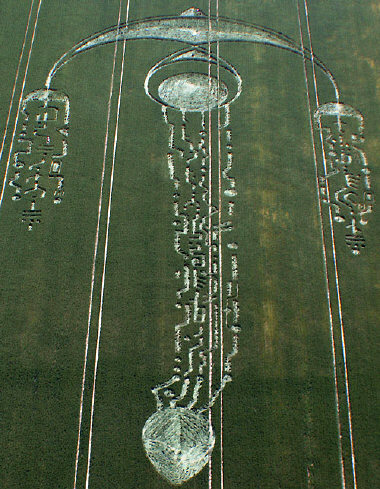 |
First appearance of peculiar "heiroglyphics" as part of a crop circle on
June 27, 2009 at South Field, Wiltshire. Photo: Jack Turner |
All seed-head & node photos are the property of the BLT Research Team Inc and may be used by others with written permission from Nancy Talbott. Please contact individual photographers of various crop formations if permission is desired to use their photos. |
This formation, which was the first to contain what some people interpret as a writing system of some kind, was examined only briefly by our fieldworker and the number of samples collected were, again, too few to form any clear impression as to causality. However, the wheat plants, which were only partially flattened throughout, do show expulsion cavities in nearly all of the 2nd nodes beneath the seed-heads and the seed-head development does appear stunted in the few samples we have -- both good indicators of the presence of microwave radiation at the time this crop circle was formed. On the other hand, the apical nodes do not appear to be elongated, an unusual finding when expulsion cavities are present in the lower nodes.
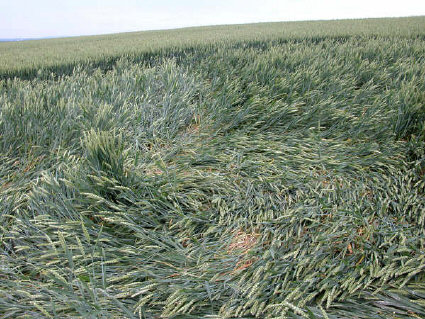 |
Very fluffy "soft" lay inside the South Field June 27th
formation. Photo: Mike Callahan |
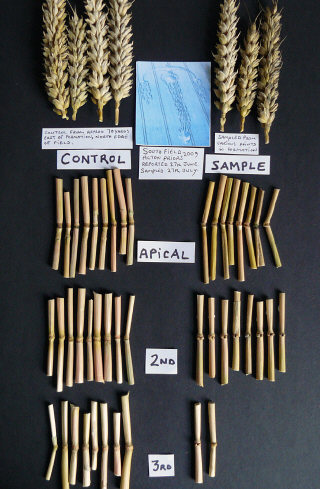 |
Samples from various locations inside formation 1 month after it
appeared show possible affect on seed-heads and expulsion
cavities in 2nd & 3rd nodes, but no apical node elongation. |
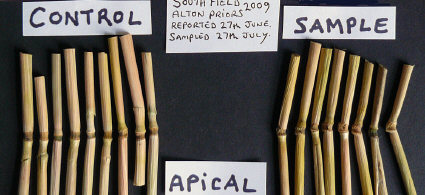 |
No lengthening of apical nodes is apparent between samples
& controls in close-up photo. |
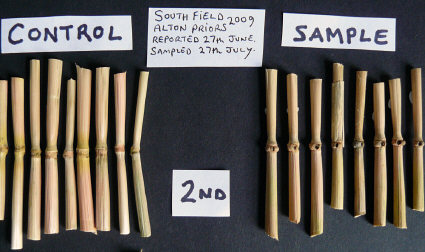 |
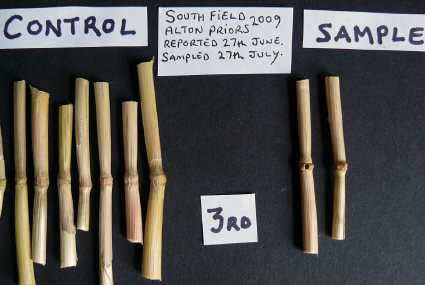 |
Most 2nd and a few 3rd nodes in the South Field formation
do contain clear expulsion cavities. |
Evidence that Cut-Out & "Repeat" Formations
Were Both Genuine
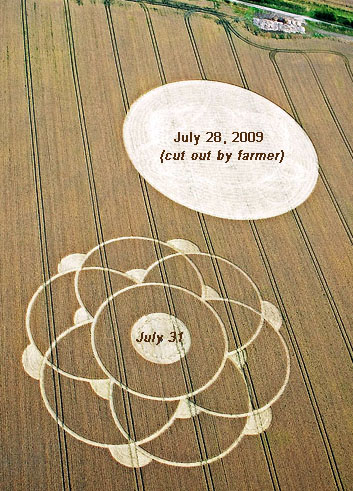 |
Two formations at Winterbourne Bassett, the 2nd circle appearing
3 days after farmer had cut out the first.
Photo: Eva Marie Brekkesto. |
Several formations occurred in 2009 which were immediately cut out of the fields by the farmers and in several of these cases a new formation (or an "addition" to the one that had been destroyed) occurred almost immediately afterward -- either in the same field, or nearby. It was a stroke of luck that our fieldworker managed to get to one of these cases, arriving back in Wiltshire on July 31st just as the 2nd formation at Winterbourne Bassett appeared (and only 3 days after the 1st one had arrived).
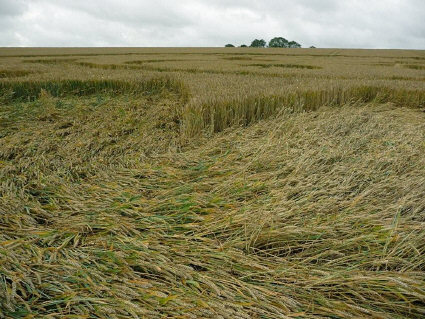 |
One of the few ground photos taken in the first (July 28) Winterbourne Bassett circle.
Photo: Isabelle Delmar. |
Because the tops of the plants in the first formation had been cut only the bottom two nodes were available for examination, and many of these cut stalks showed clear node bending at the 3rd node below the seed-head. Since only three days had elapsed -- and since photo- and/or gravitropism (the natural recovery processes of downed plants as they right themselves to sunlight and gravity) does not occur to any significant degree in crop as mature and dry as this -- the node bending here is highly indicative of the plants having been exposed to a plasma energy system discharge.
The samples from the cut formation also showed expulsion cavities in both of their lower nodes (again, just 3 days after the circle had appeared), another good indicator of exposure to microwave radiation.
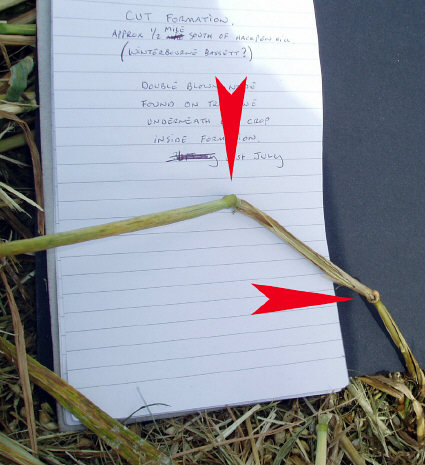 |
Multiple expulsion cavities were seen in 3rd and 4th nodes of cut stems in
Winterbourne Bassett #1, with significant bending at 3rd node. |
So far as we know no intact plants were sampled and therefore no apical node evaluation is possible, but based on the presence of clear bending of the 3rd node & expulsion cavities in both lower nodes just 3 days after the circle formed it is highly unlikely that this event can be attributed to "pranks with planks."
Our fieldworker was able to examine the 2nd Winterbourne Bassett circle the same day it appeared, only hours afterward. In this formation partial seed-head dehydration, node-bending (present that very first day), node elongation in the 2nd nodes, and expulsion cavities in the 3rd nodes are very strong indicators of authenticity, particularly because these plant changes were all present immediately.
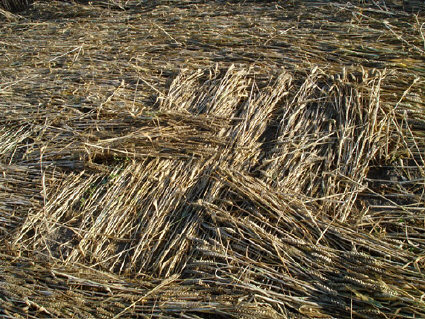 |
Interesting "cross-hatchng" in flattened plants at intersections inside
Winterbourne Bassett #2. Photo: Peter Tadd. |
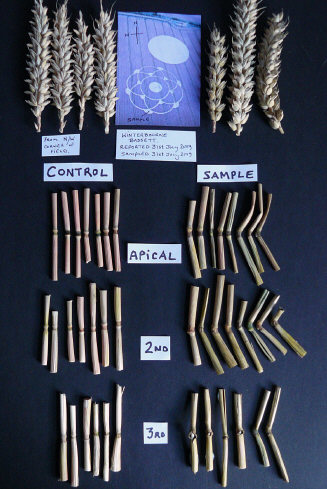 |
Samples from Winterbourne Bassett #2, taken the
same day it appeared. |
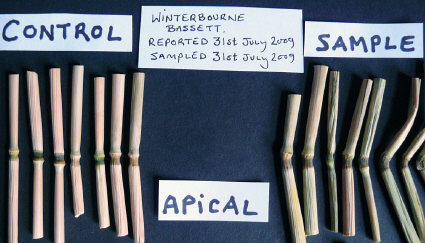 |
Node bending in samples taken the same day formation #2 occurred
(in very dry crop) cannot be due to photo -- or gravitropism. |
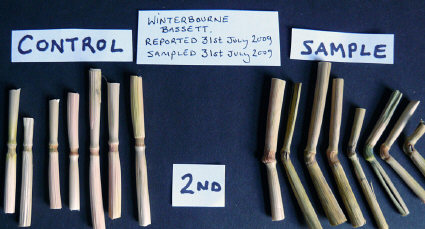 |
Node bending (and what also appears to be node elongation) in 2nd
nodes of #2 cannot be due to natural recovery processes. |
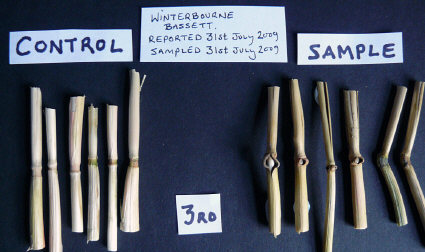 |
Clear expulsion cavities found in 3rd nodes of #2 on same
day it appeared. |
Plant Effects on Standing Crop In-Between
Two Formations
Because of the proximity of the two formations, and because the BLT plant work during the 1990s revealed that standing crop (both outside circles and inside them) is sometimes also affected, the standing plants in-between these two formations were also examined. Node elongation, marked node bending, and expulsion cavities were found throughout this standing crop in-between the two crop circles.
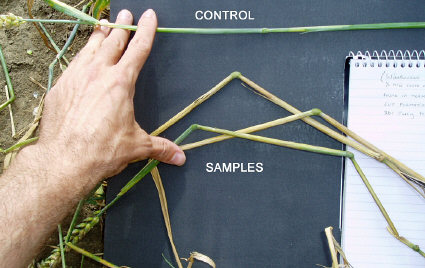 |
Node elongation and marked node bending were found in the standing
crop in-between the 2 formations. Samples all taken
on same day formation #2 appeared. |
When the crop along the edges of tram-lines in between the two formations was examined many plants were found to have multiple expulsion cavities.
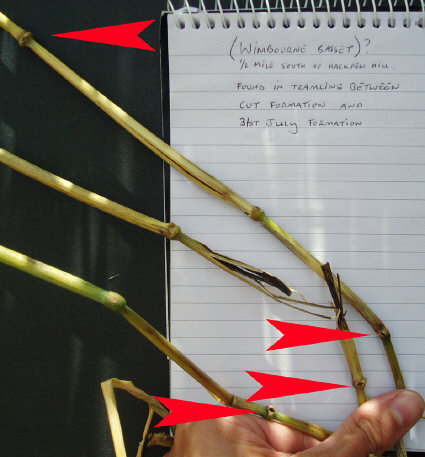 |
Expulsion cavities in lower nodes of plants along edges of tram-lines
in-between the 2 formations. |
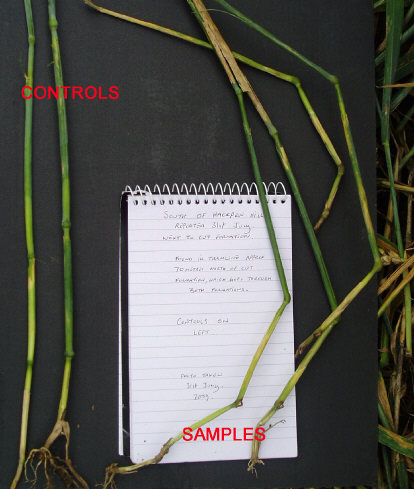 |
Marked node bending & expulsion cavities present in plants along
tramlines which ran through both formations. |
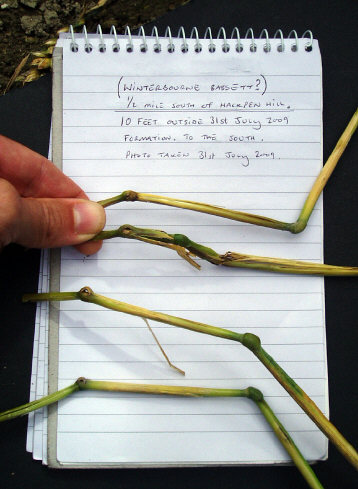 |
Again marked node bending, expulsion cavities & dehydration of plant stems
found in crop along tram-line 10 ft. south of formation #2. |
The presence of expulsion cavities in Winterbourne Bassett #1, the marked bending and expulsion cavities found in Winterbourne Bassett #2 -- on the same day it appeared -- as well as the multiple plant abnormalities found in the standing crop in-between the two formations and along the tramlines that intersected them strongly indicate that this field was exposed not just once, but twice, to microwaves emitted by a plasma discharge.
The BLT fieldworker did manage to get to a few other formations, but in these he either found very little plant change or none at all. In the July 29th Ogbourne St. Andrew "trilobite" a few of the sample seed-heads were clearly desiccated and a few apical nodes showed extreme elongation and bending the day following the formation's appearance. But in both the Ogbourne St. Andrew formation and one at Martinsell Hill we simply don't have enough samples to offer any evaluation.
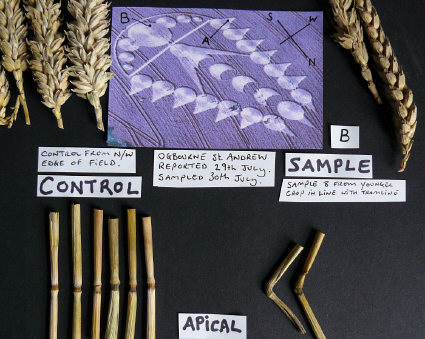 |
Dessication of seed-heads & extreme apical node bending found,
but only in a few samples, the day after circle occurred. |
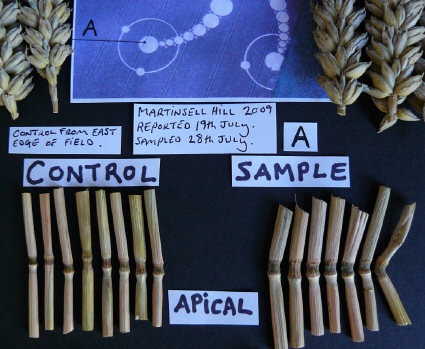 |
July 19th Martinsell Hill formation samples showed possible
apical node elongation. |
And finally there were a few other formations examined by our fieldworker in which he saw no evidence of any plant abnormalities. Node bending was observed in the May 25th Windmill Hill formation which was visited 6 days after it appeared. But this degree of node bending in young and vigorously-growing crop -- particularly since no other plant abnormalities were seen -- is almost certainly due to the natural plant recovery processes (phototropism and gravitropism).
In young crop these natural recovery processes begin immediately if the plants are not killed when flattened, and control studies have shown that the degree of node bending visible here can occur within six days when young plants are downed early in their growth-stage.
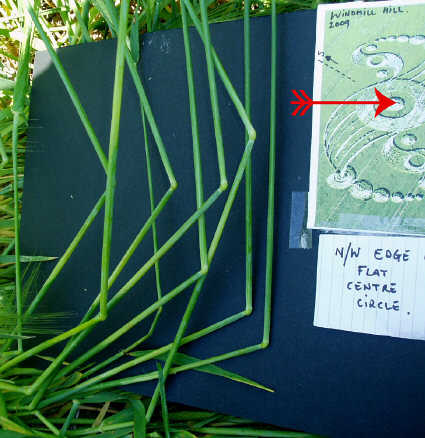 |
Node bending in May 25th Windmill Hill circle is (in the absence of any
other visible plant change) probably due to these very young
plants reorienting themselves to sunlight & gravity. |
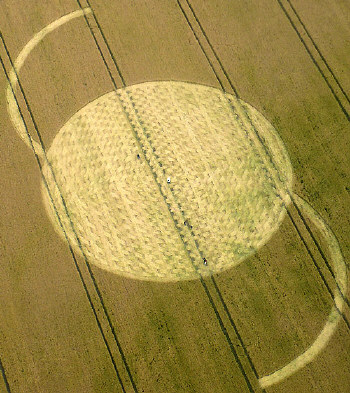 |
July 14th East Field "woven" formation. No plant abnormalities found in
any of the circle plants examined. Photo: Russell Stannard. |
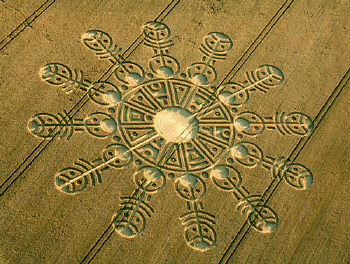 |
July 24 "snowflake" at Smeathe's Plantation (Ogbourne Down Gallop)
also showed no plant abnormalities whatsoever.
Photo: Lucy Pringle. |
Readers must remember that in none of the formations discussed here was a full-scale sampling with subsequent laboratory testing carried out. Without in-depth sampling and some of the testing that can only be conducted in the lab, we can offer only educated observations based on the extensive work carried out and published ( http://www.bltresearch.com/published.php) in the 1990s.
This report is intended primarily as a guide for those crop circle enthusiasts interested in learning about the physical changes to plants in crop circles -- the visible plant abnormalities which have been scientifically determined to be significant indicators of the effects of an energetic plasma discharge in the fields, rather than the result of mechanical flattening.
So, based on the previously published research by the BLT Research Team and the UK sampling efforts of our fieldworker in 2009, our best estimate as to the causative agency of the 2009 UK formations examined (in order as discussed in report) are as follows:
June 12th, Yatesbury "Phoenix"
June 13th, Milk Hill #2
June 27th, Honey Street circle
July 6th, Honey St. "addition"
June 21, 23 & 30, Milk Hill "3-phase"
June 21, Milk Hill small circle
June 23, Milk Hill "addition" (#4)
July 5th, Silbury Hill "Mayan Mask"
June 24th, Rough Hill "Mushroom"
June 27th, South Field
July 28th, Winterbourne Bassett (cut)
July 31st, Winterbourne Bassett #2
July 29th, Ogbourne St. Andrew
July 19th, Martinsell Hill
May 25th, Windmill Hill
July 14th, East Field "woven"
July 24th, Smeathe's Plantation | -plasma discharge
-plasma discharge
-plasma discharge
-possible plasma discharge
-possible plasma discharge
-no data
-plasma discharge
-possible plasma discharge
-plasma discharge
-possible plasma discharge
-likely plasma discharge
-plasma discharge
-inadequate data
-inadequate data
-mechanically flattened
-mechanically flattened
-mechanically flattened |
Evidence of (Hungry) Wild Critters
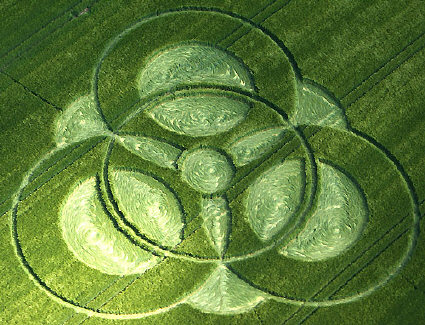 |
June 5th Chiseldon/New Farm formation in barley, with intricate
lay patterns. Photo: Andrew Pyrka. |
Our valued Norwegian colleague ( http://www.cropcirclesnorway.com/), Eva-Marie Brekkesto, visited this formation on July 18th, 41 days after it had appeared, and noticed that the seed-heads in the larger flattened areas were all either apparently very poorly developed or missing altogether. She also noted that the seed-heads in the narrow internal ring bordered on both sides by standing crop appeared normal and intact.
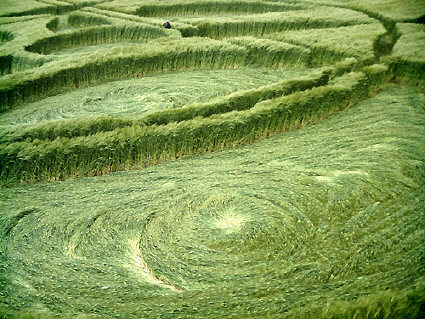 |
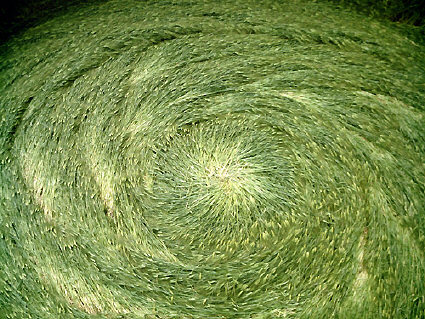 |
Spectacular lay details photographed on June 6th by Robert Armstrong who
remarks that, although he did see bending at the base of the plants
(young barley can be flattened without breakage at the base),
he saw no "clearly bent nodes." |
Mr. Armstrong's photos seem to indicate that the seed-heads were present when the formation first occurred, but he has posted no close-up photos of the plants and makes no mention of the seed-heads at all. Since we have no other information regarding the plants near the date of discovery and know that Eva-Marie's observations were made more than a month later, we suspect her photos -- which clearly show that the seed-heads are, indeed, almost entirely missing or appear to be very poorly developed in the larger flattened areas -- reflect the presence of hungry birds and mice.
Once the plants are down the seed-heads are readily accessible to the wild creatures which are (because the downed plants provide easy access to their food source) almost certainly as delighted with the circle phenomenon as any of us.
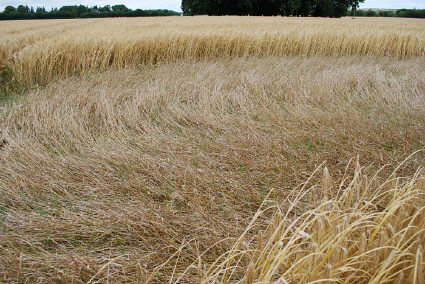 |
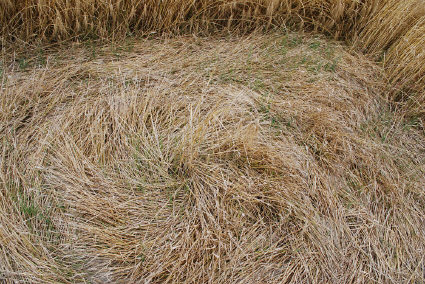 |
Larger flattened areas are almost devoid of seed-heads 41 days after
circle appeared. Photos: Eva-Marie Brekkesto. |
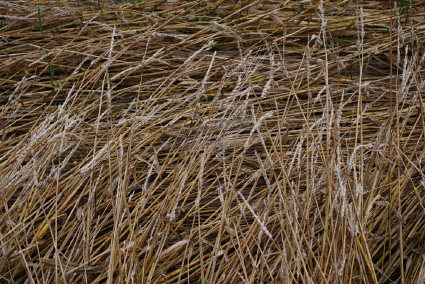 |
Missing seed-heads have most likely been picked nearly clean by the
local wild residents. Photo: Eva-Marie Brekkesto. |
__________________
We thank all of our European and American colleagues who have contributed information and shared their photos for this report. It also could not have been produced without the terrific assistance of our observant UK fieldworker (who prefers to keep a low profile, at least for the time being). We, also, have noticed in the past that a great deal more can be accomplished in the fields when one is alone and totally focussed on the task at hand.
However, one has to wonder just how "alone" our intrepid fieldworker really was -- at least on this late summer afternoon in the 3-phase Milk Hill formation. He had been working in the field for awhile and, so far as he knows, he was absolutely alone...but just as he was finishing his sampling he took a few photos, in one of which this unseen companion appears.
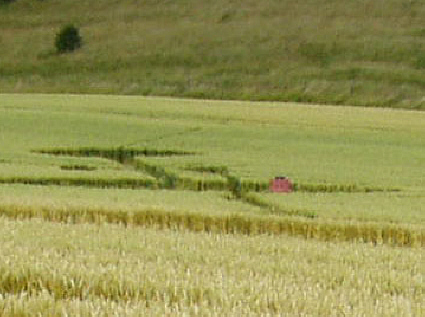 |
While sampling in the 3-phase Milk Hill formation late one day and all alone
our fieldworker took a few shots before he left for dinner. Was this
pink "pig man" there to keep him company? |
__________________
Addendum......
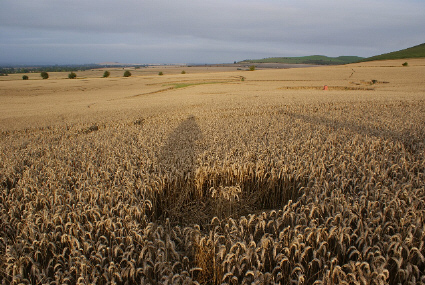 |
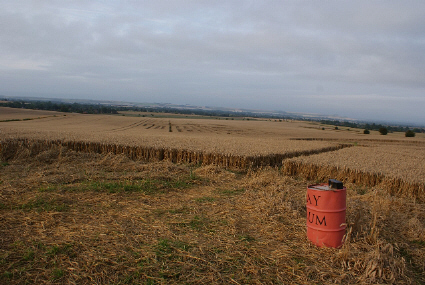 |
Thanks to these photos from Andrew Pyrka ( http://www.cropcirclewisdom.com)
our pink "pig-man" is identified...just the farmer's "honesty box" out in the
middle of the formation. One mystery solved at least...
|
|
|
|
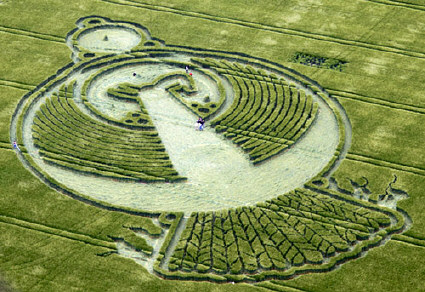




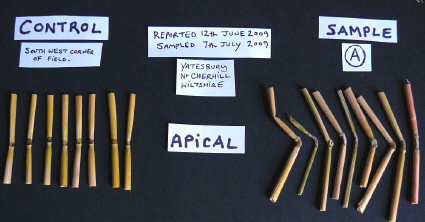
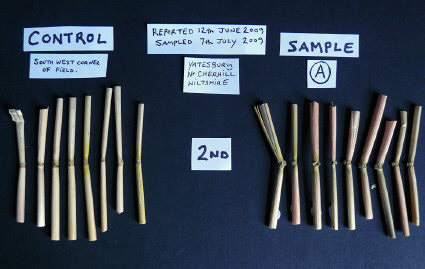
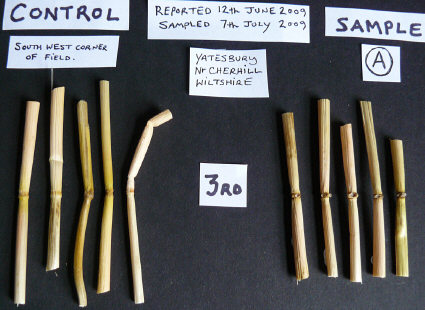







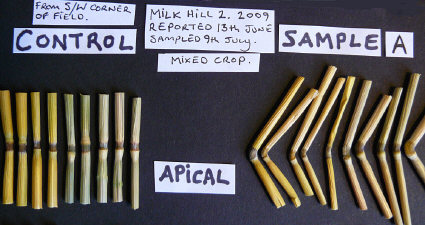
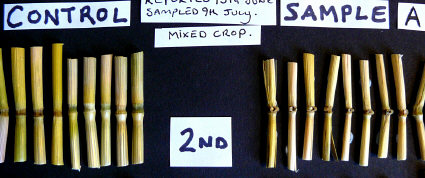
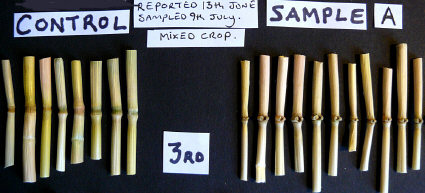

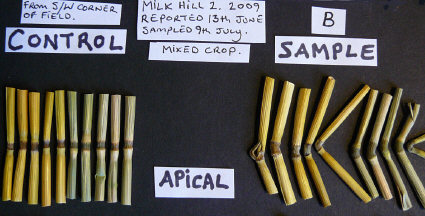
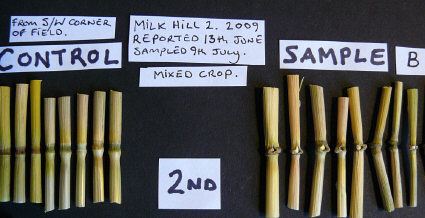
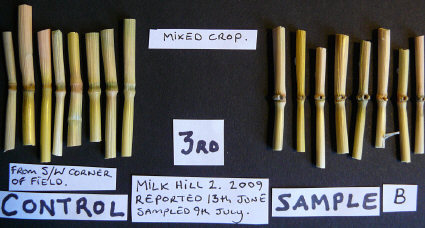
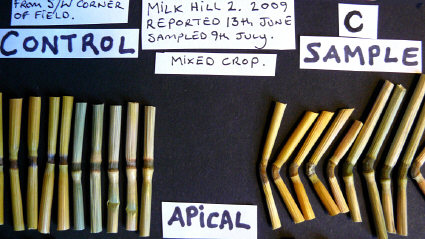
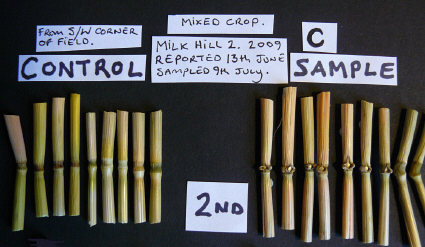
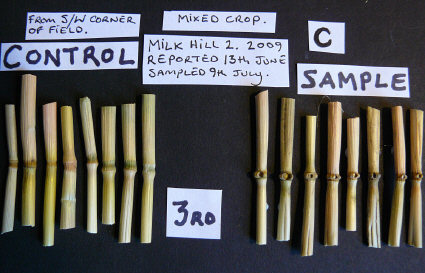


















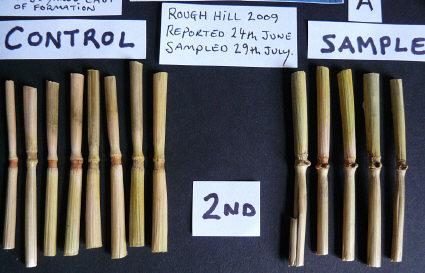
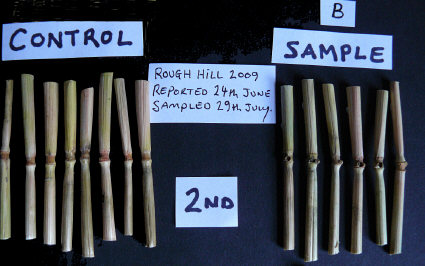
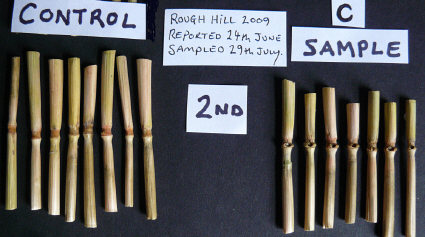








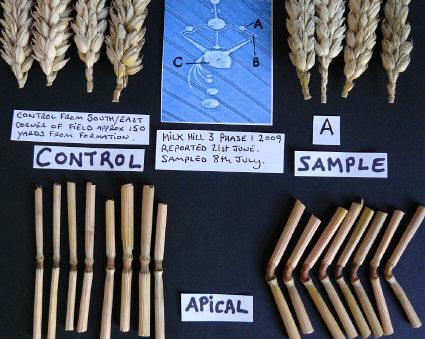
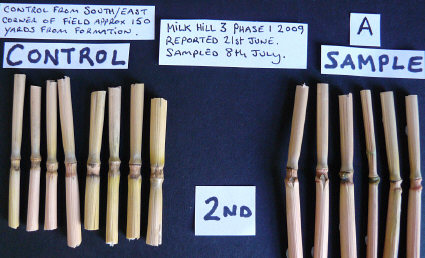
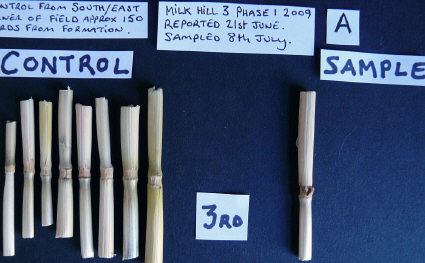




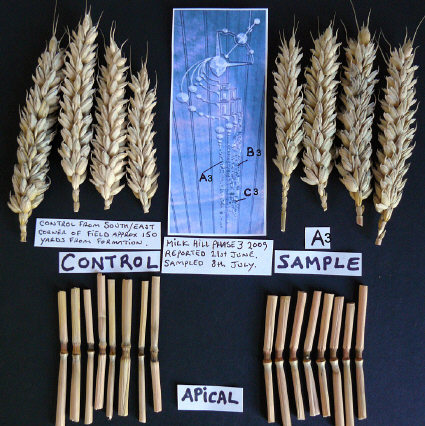
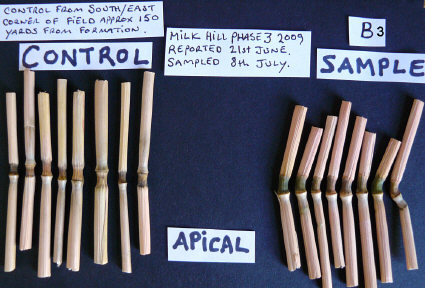
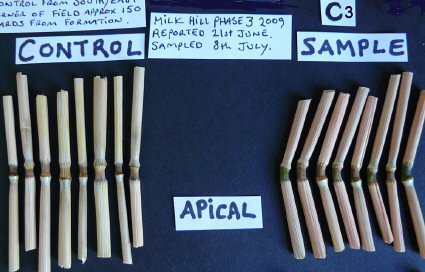







































No comments:
Post a Comment